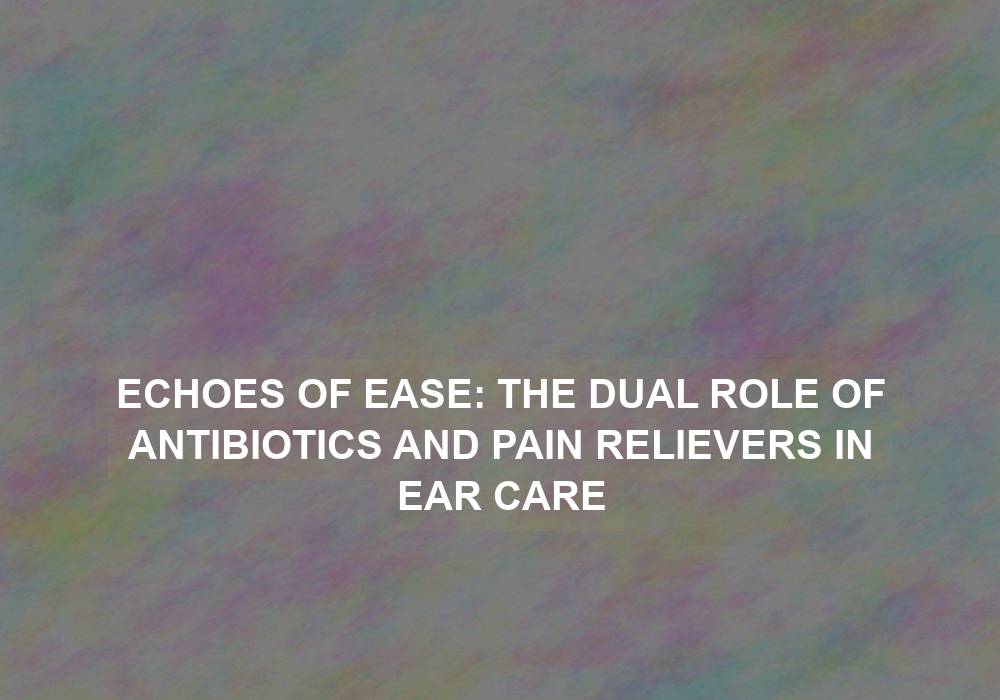The health of our ears is of utmost importance in maintaining a high quality of life. Whether it’s the joy of listening to music or engaging in meaningful conversations, our ears play a significant role in our daily activities. Unfortunately, ear infections and pain can disrupt this harmony, causing discomfort and affecting our overall well-being. In such cases, antibiotics and pain relievers serve as essential tools in ear care, providing relief and aiding in the healing process.
Antibiotics: Guardians Against Infection
Ear infections, medically known as otitis media, can affect people of all ages, from children to adults. These infections are often caused by bacteria and viruses, leading to inflammation and discomfort in the middle ear. Antibiotics play a vital role in combating these microbial invaders, clearing the infection, and preventing further complications.
Types of Antibiotics for Ear Infections
- Amoxicillin: This broad-spectrum antibiotic is commonly prescribed for ear infections. It effectively targets a wide range of bacteria, making it a popular choice for treating otitis media. Its effectiveness lies in its ability to inhibit the growth of bacteria by preventing them from forming cell walls.
- Augmentin: In cases where the infection is caused by bacteria that are resistant to amoxicillin alone, a combination medication called Augmentin may be prescribed. Augmentin contains amoxicillin and clavulanic acid, which enhances its effectiveness against resistant bacteria.
- Cefuroxime: If the infection persists or if an individual is allergic to penicillin-based antibiotics, cefuroxime may be prescribed. This antibiotic works by interfering with the synthesis of bacterial cell walls, ultimately leading to the destruction of bacteria.
Proper Usage of Antibiotics
To ensure the effectiveness of antibiotics and prevent the development of antibiotic resistance, it is crucial to follow the prescribed dosage and complete the full course of treatment. This is because stopping the medication prematurely may allow some bacteria to survive, potentially leading to the development of antibiotic-resistant strains. It is also essential to consult a healthcare professional before taking any medication, as they can determine the most appropriate antibiotic based on the individual’s medical history and the severity of the infection.
Proper usage of antibiotics also involves understanding any potential side effects and taking necessary precautions. Some common side effects of antibiotics include gastrointestinal disturbances, allergic reactions, and the disruption of natural gut flora. It is important to be aware of these possibilities and seek medical advice if any adverse reactions occur.
Pain Relievers: A Soothing Balm for Ear Discomfort
Ear infections often come with pain and discomfort, which can make it challenging to concentrate and carry out daily activities. Pain relievers, also known as analgesics, provide much-needed relief by easing the discomfort associated with ear infections.
Types of Pain Relievers for Ear Pain
- Acetaminophen: Commonly known by its brand name Tylenol, acetaminophen is widely used to reduce pain and fever. It is often recommended for individuals of all ages, including children. Acetaminophen works by inhibiting the production of certain chemicals in the body that are responsible for transmitting pain signals.
- Ibuprofen: As a nonsteroidal anti-inflammatory drug (NSAID), ibuprofen helps alleviate pain and reduce inflammation. It is commonly available over-the-counter and is suitable for individuals above a certain age, as advised by healthcare professionals. Ibuprofen works by inhibiting the production of prostaglandins, which are chemicals responsible for promoting inflammation and transmitting pain signals.
- Topical Anesthetics: Some ear drops contain local anesthetics such as benzocaine to numb the ear, providing temporary relief from pain. These topical anesthetics work by blocking the nerve signals that transmit pain sensations to the brain.
Proper Usage of Pain Relievers
It is essential to carefully follow the instructions provided by healthcare professionals or indicated on the packaging of pain relievers. Adhering to the recommended dosage and frequency of administration is crucial to prevent any potential side effects. Overdosing on pain relievers can lead to liver damage, gastrointestinal bleeding, and other serious health complications. Additionally, individuals should consult a healthcare professional before administering pain relievers to children or if they have any pre-existing medical conditions, such as liver or kidney disease.
Combining Antibiotics and Pain Relievers: The Synergistic Effect
In certain cases, healthcare professionals may recommend the simultaneous use of antibiotics and pain relievers to maximize the effectiveness of treatment and provide comprehensive relief. This combination helps to address both the underlying infection and the associated pain, alleviating discomfort and promoting a speedier recovery.
Precautions and Considerations
It is essential to inform healthcare professionals about any existing medical conditions, allergies, or medications being taken before starting antibiotic and pain reliever treatments. Certain drugs may interact with one another, potentially causing adverse effects. By providing a complete medical history, individuals can ensure their safety and the effectiveness of the prescribed treatment.
Furthermore, it is crucial to bear in mind that antibiotics and pain relievers are not a one-size-fits-all solution. The choice of medication may vary depending on the individual’s age, medical history, and the severity of the ear infection. Therefore, seeking professional medical advice is vital to determine the most suitable course of treatment.
Conclusion
In the realm of ear care, antibiotics and pain relievers stand as powerful allies, playing a dual role in combating infections and alleviating discomfort. These medications, when used appropriately and under the guidance of healthcare professionals, offer effective relief and aid in the healing process. However, it is crucial to remember that each individual’s situation is unique, and seeking professional medical advice is paramount for optimal ear care. By understanding the echoes of ease created by antibiotics and pain relievers, we can ensure a harmonious relationship with our ears and embrace a life free from the clutches of ear infections and pain.
